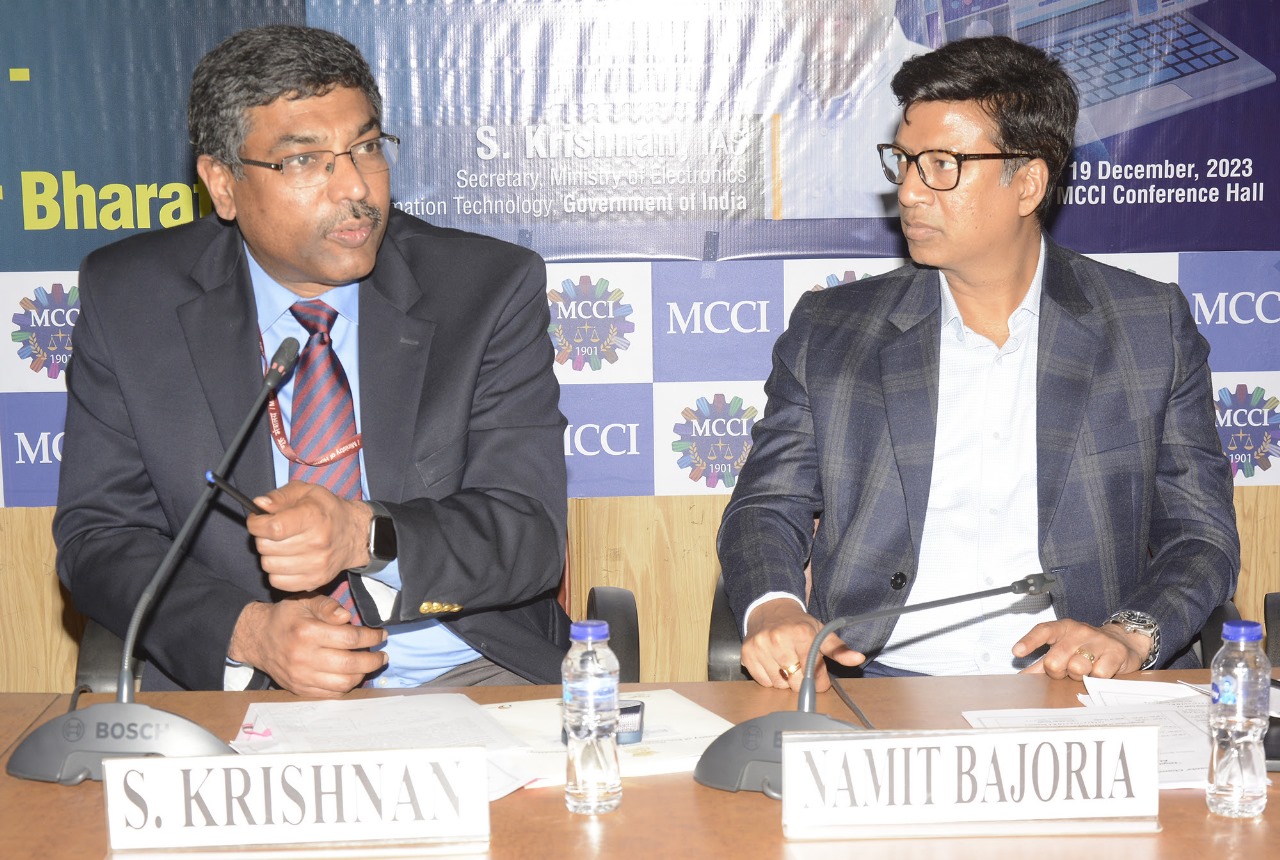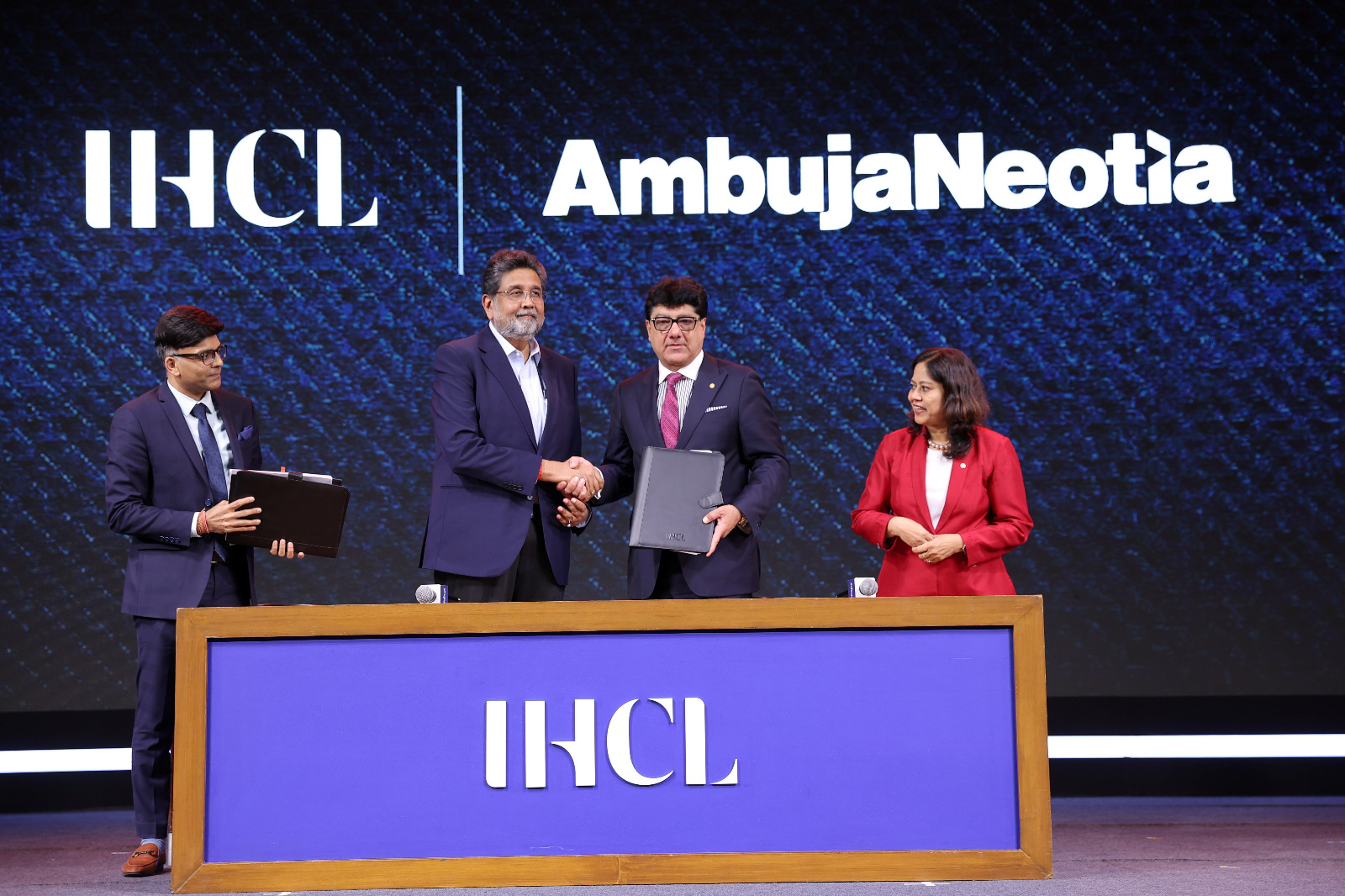Merchants’ Chamber of Commerce & Industry organised a Special Session on ‘Digital India – Enabler for Atmanirbhar Bharat’on Tuesday, 19 December 2023 at MCCI.
The session was addressed by Shri S. Krishnan, IAS, Secretary, Ministry of Electronics & Information Technology, Government of India.
Shri S. Krishnan in his address said thatIndia’s software exports amount to USD 245 billion and hardware exports are about USD 100 billion. The goal is to raise the amount of software and electronics exports from USD 350 billion to USD 1 trillion within the next 5-7 years.
The digital sector underpins what is happening in other industries and it facilitates growth. Gita Gopinath of the IMF has said that AI represents an opportunity as big as the First Industrial Revolution of the 18th and 19th centuries. Countries of the South have the opportunity to use technology to leapfrog the developed countries.
Electronics holds the promise of becoming the largest single sector in the world.India needs to grow in electronics. Electronics are made in 50 – 60 nations whose competitiveness is based on local costs. So, electronics has a global value chain and India must increase its share of it.
In earlier decades, India agreed to zero duties on electronics which wiped out the Indian electronics industry. Now, the manufacturing of electronics has become important in India. Today, 99.2% of mobiles are Made in India. Earlier, a PLI Scheme for mobile phones was launched. Today, a PLI Scheme for IT hardware has been launched.
Shri Krishnan mentioned that the share of value addition for mobile phones in India is only about 15%. However, he pointed out that it is a global value chain and even China has only 40% to 45% share of the global value chain. The electronics industry offers huge employment opportunities and Foxconn employs 50,000 people in Tamil Nadu. If India wants to be competitive, it needs to bring more of the value chain to India.
Only a few nations like Taiwan make semiconductors. Shri Krishnan said that “We need a more resilient value chain for semiconductors”. The Indian Semiconductor Mission has been launched, which provides 50% assistance from the Central Government and 20% subsidy from some states. Subsidies will be paid on a pari passu basis. The Indian semiconductor industry needs an investment of Rs. 75,000 crores.
India is already a powerhouse in ICT. It helped to have trained people in STEM. Global capability centers have come up and many ICT companies are trying to diversify locations in India to reduce risk.
Data Centers are gaining prominence and they are largely concentrated in Mumbai and Chennai as sea cables are linked to these cities. Data Centers are spreading to Bangalore, Hyderabad, and Pune too.
While talking about emerging technologies, Shri Krishnan said that AI helps to improve productivity across sectors. Skilling, re-skilling, and upskilling of AI workers is important. India will Chair the Global Partnership AI Summit in 2024, which may enable it to shape the AI discourse.
Among the risk factors, cybercrime is an issue and it is essentially a ‘confidence trick”. Shri Krishnan said that regulators missed an opportunity to regulate the Internet in earlier decades. It should not make the same mistake with AI. The Indian regulation of social media balances growth and safety. GoI has enacted the Data Protection Act and it appears to be satisfactory.The upcoming Digital India Bill will provide regulation of emerging issues such as AI. Cyber security is of the highest priority to GoI.Shri Krishnan ended by saying that India must create digital productsand also own the IP rights.
Shri Namit Bajoria, President, MCCI in his Welcome Address said thatthe Indian IT industry is expected to grow to USD 350 billion by 2030 from USD 200 billion at present with the potential to double the employment opportunities in the next 10 years.
One of the main ways digitization has impacted India’s economy tremendously is through e-commerce and increased adoption of online payments thereby transforming the whole idea of how people transact and access banking services. The success of Digital payments, PLI Scheme and Atmanirbhar Bharat have shaped India’s position in the global space. India’s 5G network rollout has caught the world’s attention as it is the fastest rollout anywhere in the world. In recent years, digital technologies have made India an attractive destination for investment. Also, as countries are adopting China plus one strategy and with India’s advantage in having a combination of manufacturing and software advantages, the country is poised to become a global manufacturing hub in the coming days.
Artificial intelligence (AI) is the key to driving commercial development for the world. India’s growing semiconductor industry will be the backbone of the Indian AI Market and by 2025, the Indian AI market will be worth USD 7.8 bn.
Shri Yashovardhan Gupta, Chairman, Council on IT & Communication, MCCI in his Theme Address said that among the nations embarking on this digital voyage, India’s endeavor stands out, particularly through the ‘Digital India’ initiative. The IT industry accounted for 7.4% of India’s GDP in FY22 and it is expected to contribute to 10% of India’s GDP by 2025.
The primary objective of Digital India’s mission is ‘Power to Empower’. The three core components are as follows:
Digital Infrastructure as a Core Utility to Every Citizen
Governance & Services on Demand and
Digital Empowerment of Citizens
Digital India has been termed as the Sadhana of Atmanirbhar Bharat. One of the resounding successes of the Digital India initiative has been its role in significantly improving Internet accessibility. India is viewed by the rest of the world as having the second-largest online market with the cheapest Internet rates, with 760 million citizens now having access to the Internet. The 5G networks are now live in multiple cities. While Internet penetration stood at 48.7% at the beginning of 2023, India was home to 467 million social media users in January 2023, equating to around 32.8% of the total population.
Shri S. Krishnan inaugurated the MCCI IT Help Desk at the end of the programme.
The Session ended with a Vote of Thanks proposed by Shri Sanjib Sanghi, Co-Chairman, Council on IT & Communication, MCCI.




